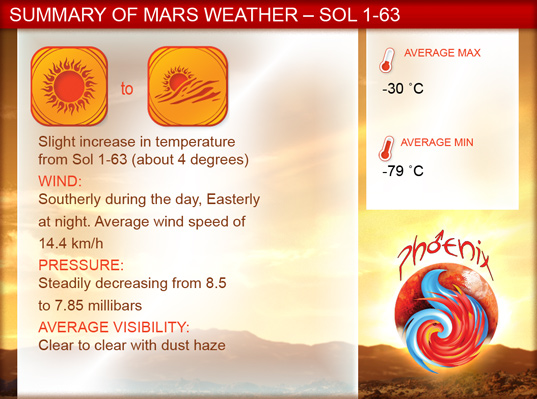[/caption]
More early morning frost is showing up on the Phoenix spacecraft. The Surface Stereo Imager (SSI) took several pictures of the “Telltale” on the Phoenix Mars Lander, the device used to measure wind velocities at the landing site on Mars and created a movie of bright specks of frost accumulating on the mirror of the Telltale. The movie was created from a series of images taken by the Surface Stereo Imager (SSI)between 12:54 a.m. and 2:34 a.m. during the 80th Martian day, or sol, of the mission (Aug. 15, 2008 here on Earth). Sorry, we couldn’t load the movie on this page, the file was too big. But follow this link to see it — the frost is very cool (pun intended).
Phoenix’s SSI took these images through a blue filter (450 nanometer wavelength) that is used primarily for viewing items on the spacecraft rather than the workspace or horizon. In order to increase the number of frames, the size of the individual images downlinked from the spacecraft has been reduced. These have been shown superimposed upon a full image of the telltale from Sol 13 for context. The frost on the mirror sparkles in low-angle light from the sun, which is barely above the horizon at this hour.
Via Twitter, the Phoenix spacecraft said not to worry, this type of early morning frost is not a concern for the operation of the spacecraft.
The Telltale experiment is a passive instrument that provides information about winds at the landing site. It consists of a lightweight Kapton tube hanging in Kevlar fibers that will deflect as a result of wind forces. Images of the Telltale obtained by the onboard camera (SSI) using long exposure times provide information on the deflection and dynamics that can be related to wind velocities and turbulence.
During the early-morning period when these images were taken the wind was blowing steadily at about 5 meters per second (about 11 miles per hour) from the northeast, as indicated by the telltale.
The telltale is about 10 centimeters (4 inches) tall and the total mass of the active part is about 10 mg. The experiment was built by the University of Aarhus, Denmark.

Here’s some info on the weather on Mars, although Sol 63 is the latest available from the Mars Weather Station on Phoenix. To learn more about the Weather Station, follow this link.


These reports of frost are extremely significant. They show that the lower atmosphere is carrying water vapour. In turn, that also means there is active sublimation from the surface. This is the same story as methane. You cannot have either without replacement on a continuous basis.
Now take this news and relate it to the deep valleys where the temperature will rise by 3 degrees per thousand feet, (adiabatic lapse rate), as you descend and we can see there is the clear potential for liquid water at the bottom of some of the deep valleys.
We need an expedition to the bottom of one to discover if this would be correct.
Cool indeed.
More coolness, discussions of pressure in deep mines (as regards biology) taught me about hydrostatic equilibrium and barometric formulas, and now we have the thermodynamics of the atmosphere.
Just checking the units; seeing that we have low pressure and temperature, I will make a wild guess that it doesn’t matter much whether one uses the dry or saturated lapse rate, making using the dry rate so much more robust. So, at Mars gravity that would be ~ 3 Celsius/km or ~ 2 Fahrenheit/1000 feet. The above is all in imperial units then.
I don’t have the chops to check if there will be potential for liquids (but I see some reference papers that could teach me I guess): “‘Liquid water is typically stable at the lowest elevations and at low latitudes on the planet because the atmospheric pressure is greater than the vapor pressure of water and surface temperatures in equatorial regions can reach 273 K for parts of the day [Haberle et al., 2001]'”
So Mars isn’t only incredibly cool, it has hotness as well.
And yes indeed, on the suggested expedition. Though, if Phoenix uncovers evidence of liquid water episodes associated with the current nature of the polar regions, I have to wonder if a deep valley expedition will be a high priority at first.